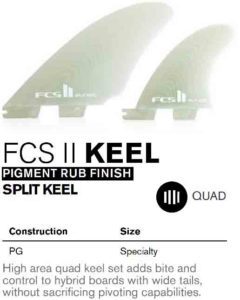Description

€155.00
Taking your beloved hybrid down a new road, the FCS II Split Keel Quad Fin Set allows for superior steering abilities in boards with wider tails. Offering quick, loose turns, these quads have just enough bite to wrap around solidly while reserving speed for the next section. Excelling in big, open faces and clean, down-the-line waves, the Split Keel Quads supply you with high surface area and a stiff base that will enable a smooth flow of carves all the way back into the channel.
PERFORMANCE GLASS
Performance Glass (PG) material characteristics and flex pattern are identical to traditional fiberglass fins offering a stiff base with subtle responsive tip flex, amazing aesthetics, and proven durability. PG fins are the perfect transition fin for surfers moving from fixed fins to the convenience, accuracy, and performance of FCS.
FLAT FOIL
A flat inside face combined with a convex outside face. The traditional flat sided foil offers an even combination of drive, pivot and holds and provides a very consistent, reliable feel over a wide variety of conditions.
80/20 FOIL
Combines the performance of a center and side fin offering increased speed, smooth rail-to-rail transitions, and a consistent feel in a variety of conditions. (Ideal for all board types and rear fin placements)
SIDES
REARS
In stock
